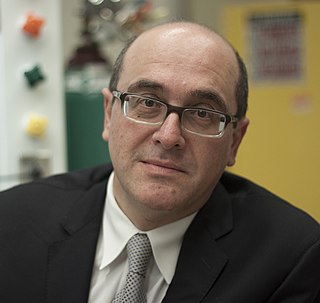Related Research Articles

Forward osmosis (FO) is an osmotic process that, like reverse osmosis (RO), uses a semi-permeable membrane to effect separation of water from dissolved solutes. The driving force for this separation is an osmotic pressure gradient, such that a "draw" solution of high concentration, is used to induce a net flow of water through the membrane into the draw solution, thus effectively separating the feed water from its solutes. In contrast, the reverse osmosis process uses hydraulic pressure as the driving force for separation, which serves to counteract the osmotic pressure gradient that would otherwise favor water flux from the permeate to the feed. Hence significantly more energy is required for reverse osmosis compared to forward osmosis.

Nafion is a brand name for a sulfonated tetrafluoroethylene based fluoropolymer-copolymer discovered in the late 1960s by Dr. Walther Grot of DuPont. Nafion is a brand of the Chemours company. It is the first of a class of synthetic polymers with ionic properties that are called ionomers. Nafion's unique ionic properties are a result of incorporating perfluorovinyl ether groups terminated with sulfonate groups onto a tetrafluoroethylene (PTFE) backbone. Nafion has received a considerable amount of attention as a proton conductor for proton exchange membrane (PEM) fuel cells because of its excellent chemical and mechanical stability in the harsh conditions of this application.

Polyelectrolytes are polymers whose repeating units bear an electrolyte group. Polycations and polyanions are polyelectrolytes. These groups dissociate in aqueous solutions (water), making the polymers charged. Polyelectrolyte properties are thus similar to both electrolytes (salts) and polymers and are sometimes called polysalts. Like salts, their solutions are electrically conductive. Like polymers, their solutions are often viscous. Charged molecular chains, commonly present in soft matter systems, play a fundamental role in determining structure, stability and the interactions of various molecular assemblies. Theoretical approaches to describing their statistical properties differ profoundly from those of their electrically neutral counterparts, while technological and industrial fields exploit their unique properties. Many biological molecules are polyelectrolytes. For instance, polypeptides, glycosaminoglycans, and DNA are polyelectrolytes. Both natural and synthetic polyelectrolytes are used in a variety of industries.
Microencapsulation is a process in which tiny particles or droplets are surrounded by a coating to give small capsules, with useful properties. In general, it is used to incorporate food ingredients, enzymes, cells or other materials on a micro metric scale. Microencapsulation can also be used to enclose solids, liquids, or gases inside a micrometric wall made of hard or soft soluble film, in order to reduce dosing frequency and prevent the degradation of pharmaceuticals.

Gas mixtures can be effectively separated by synthetic membranes made from polymers such as polyamide or cellulose acetate, or from ceramic materials.
An iodophor is a preparation containing iodine complexed with a solubilizing agent, such as a surfactant or water-soluble polymers, for example, povidone. The result is a water-soluble material that releases free iodine when in solution. Iodophors are prepared by mixing iodine with the solubilizing agent; heat can be used to speed up the reaction.
A proton-exchange membrane, or polymer-electrolyte membrane (PEM), is a semipermeable membrane generally made from ionomers and designed to conduct protons while acting as an electronic insulator and reactant barrier, e.g. to oxygen and hydrogen gas. This is their essential function when incorporated into a membrane electrode assembly (MEA) of a proton-exchange membrane fuel cell or of a proton-exchange membrane electrolyser: separation of reactants and transport of protons while blocking a direct electronic pathway through the membrane.
Barrer is a non-SI unit of gas permeability used in the membrane technology and contact lens industry. It is named after Richard Barrer.

Nanoporous materials consist of a regular organic or inorganic bulk phase in which a porous structure is present. Nanoporous materials exhibit pore diameters that are most appropriately quantified using units of nanometers. The diameter of pores in nanoporous materials is thus typically 100 nanometers or smaller. Pores may be open or closed, and pore connectivity and void fraction vary considerably, as with other porous materials. Open pores are pores that connect to the surface of the material whereas closed pores are pockets of void space within a bulk material. Open pores are useful for molecular separation techniques, adsorption, and catalysis studies. Closed pores are mainly used in thermal insulators and for structural applications.
Poloxamers are nonionic triblock copolymers composed of a central hydrophobic chain of polyoxypropylene flanked by two hydrophilic chains of polyoxyethylene. The word poloxamer was coined by BASF inventor, Irving Schmolka, who received the patent for these materials in 1973. Poloxamers are also known by the trade names Pluronic, Kolliphor, and Synperonic.
Nanofiltration is a membrane filtration process used most often to soften and disinfect water.

Poly(acrylic acid) (PAA; trade name Carbomer) is a polymer with the formula (CH2-CHCO2H)n. It is a derivative of acrylic acid (CH2=CHCO2H). In addition to the homopolymers, a variety of copolymers and crosslinked polymers, and partially deprotonated derivatives thereof are known and of commercial value. In a water solution at neutral pH, PAA is an anionic polymer, i.e., many of the side chains of PAA lose their protons and acquire a negative charge. Partially or wholly deprotonated PAAs are polyelectrolytes, with the ability to absorb and retain water and swell to many times their original volume. These properties – acid-base and water-attracting – are the bases of many applications.

Membrane fouling is a process whereby a solution or a particle is deposited on a membrane surface or in membrane pores in a processes such as in a membrane bioreactor, reverse osmosis, forward osmosis, membrane distillation, ultrafiltration, microfiltration, or nanofiltration so that the membrane's performance is degraded. It is a major obstacle to the widespread use of this technology. Membrane fouling can cause severe flux decline and affect the quality of the water produced. Severe fouling may require intense chemical cleaning or membrane replacement. This increases the operating costs of a treatment plant. There are various types of foulants: colloidal, biological, organic and scaling.
A nanogel is a polymer-based, crosslinked hydrogel particle on the sub-micron scale. These complex networks of polymers present a unique opportunity in the field of drug delivery at the intersection of nanoparticles and hydrogel synthesis. Nanogels can be natural, synthetic, or a combination of the two and have a high degree of tunability in terms of their size, shape, surface functionalization, and degradation mechanisms. Given these inherent characteristics in addition to their biocompatibility and capacity to encapsulate small drugs and molecules, nanogels are a promising strategy to treat disease and dysfunction by serving as delivery vehicles capable of navigating across challenging physiological barriers within the body.

Interfacial polymerization is a type of step-growth polymerization in which polymerization occurs at the interface between two immiscible phases, resulting in a polymer that is constrained to the interface. There are several variations of interfacial polymerization, which result in several types of polymer topologies, such as ultra-thin films, nanocapsules, and nanofibers, to name just a few.
Phase inversion or phase separation is a chemical phenomenon exploited in the fabrication of artificial membranes. It is performed by removing the solvent from a liquid-polymer solution, leaving a porous, solid membrane.

Cardo polymers are a sub group of polymers where ring structures are pendent to the polymer backbone. The backbone carbons bonded to the pendent ring structures are quaternary centers. As such, the cyclic side group lies perpendicular to the plane of the extended polymer chain. These side rings are bulky structures which sterically hinder rotation of the backbone bonds; they also disrupt chain packing and thus create greater free volume than found in conventional polymer structures. The rotational restrictions placed on the polymer backbone increase the value of the characteristic ratio, leading to what is referred to as a "rigid" or "stiff" backbone. The sterically driven large rotational potential produces a high glass transition temperature and the disrupted packing yields comparatively high values for gas and other small molecule solubilities in these polymers. Because of these physical effects, recent advances in membranes used for gas separation have used cardo polymers.
Peter Martin Budd is a British chemist and a Professor in the Department of Chemistry at The University of Manchester. His research in general is based on polymer chemistry, energy and industrial separations, specifically on the areas of Polymers of intrinsic microporosity (PIMs), energy storage, polyelectrolytes and separation membranes.
Vitaliy Khutoryanskiy FRSC is a British and Kazakhstani scientist, Professor of Formulation Science and Royal Society Industry Fellow at the University of Reading. His research focuses on polymers, biomaterials, nanomaterials, drug delivery and pharmaceutical sciences. Khutoryanskiy has published over 200 original research articles, book chapters and reviews; his publications have attracted > 10000 citations and his current h-index is 48:. He received several prestigious awards in recognition for his research in polymers, colloids and drug delivery and also for contributions to research peer-review and mentoring of early career researchers. He holds several honorary professorship titles from different universities.

Alexander Viktorovich Kabanov, is a Russian and American chemist, an educator, an entrepreneur, and a researcher in the fields of drug delivery and nanomedicine.
References
- ↑ Tsuchida, E.; Abe, K., eds. (1982). "Interactions Between Macromolecules in Solution and Intermacromolecular Complexes". Advances in Polymer Science. 45. doi:10.1007/bfb0017548. ISBN 3-540-11624-9.
- Bekturov, Esen A.; Bimendina, Larisa A. (1981). "Interpolymer complexes". Speciality Polymers. Advances in Polymer Science. Springer Berlin Heidelberg. 41: 99–147. doi:10.1007/3-540-10554-9_11. ISBN 978-3-540-38525-7. - ↑ Kabanov, V. (2002), "Fundamentals of Polyelectrolyte Complexes in Solution and the Bulk", Multilayer Thin Films, Wiley-VCH Verlag GmbH & Co. KGaA, pp. 47–86, doi:10.1002/3527600574.ch2, ISBN 3-527-30440-1
- ↑ Khutoryanskiy, Vitaliy V.; Staikos, Georgios (2009). Hydrogen-bonded interpolymer complexes : formation, structure and applications. Singapore: World Scientific Pub. Co. ISBN 978-981-270-977-6. OCLC 613658891.
- ↑ Tsuji, Hideto (December 2016). "Poly(lactic acid) stereocomplexes: A decade of progress". Advanced Drug Delivery Reviews. 107: 97–135. doi:10.1016/j.addr.2016.04.017. PMID 27125192.
- ↑ Peredereeva, S I; Orlov, I G; Cherkashin, Mikhail I (1975-04-30). "Polymeric Charge-transfer Complexes". Russian Chemical Reviews. 44 (4): 295–305. Bibcode:1975RuCRv..44..295P. doi:10.1070/rc1975v044n04abeh002268. ISSN 0036-021X.
- ↑ Murmiliuk, Anastasiia; Hladysh, Sviatoslav; Filippov, Sergey K.; Stepanek, Miroslav (2022-09-01). "Comprehensive Multidimensional Characterization of Polyelectrolytes and Interpolyelectrolyte Complexes in Aqueous Solutions". Reviews and Advances in Chemistry. 12 (3): 163–177. doi:10.1134/S263482762260013X. ISSN 2634-8284.
- ↑ Khutoryanskiy, V. V.; Smyslov, R. Yu.; Yakimansky, A. V. (2018-09-01). "Modern Methods for Studying Polymer Complexes in Aqueous and Organic Solutions" (PDF). Polymer Science, Series A. 60 (5): 553–576. doi:10.1134/S0965545X18050085. ISSN 1555-6107.
- ↑ Khutoryanskiy, Vitaliy V. (2007-04-04). "Hydrogen-bonded interpolymer complexes as materials for pharmaceutical applications". International Journal of Pharmaceutics. 334 (1): 15–26. doi:10.1016/j.ijpharm.2007.01.037. ISSN 0378-5173. PMID 17320317.
- ↑ Fay, James M.; Kabanov, Alexander V. (2022-09-01). "Interpolyelectrolyte Complexes as an Emerging Technology for Pharmaceutical Delivery of Polypeptides". Reviews and Advances in Chemistry. 12 (3): 137–162. doi:10.1134/S2634827622600177. ISSN 2634-8284. PMC 9987408 .
- ↑ Decher, Gero (1997-08-29). "Fuzzy Nanoassemblies: Toward Layered Polymeric Multicomposites". Science. 277 (5330): 1232–1237. doi:10.1126/science.277.5330.1232. ISSN 0036-8075.
- ↑ Bromberg, L. E. (1991-10-01). "Composite membranes based on polyelectrolyte complexes". Journal of Membrane Science. 62 (2): 131–143. doi:10.1016/0376-7388(91)80057-D. ISSN 0376-7388.
- ↑ Zezin, A. B.; Mikheikin, S. V.; Rogacheva, V. B.; Zansokhova, M. F.; Sybachin, A. V.; Yaroslavov, A. A. (2015-12-01). "Polymeric stabilizers for protection of soil and ground against wind and water erosion". Advances in Colloid and Interface Science. Colloid and Polymer Interfaces in Bio-resources and Environments. 226 (Pt A): 17–23. doi:10.1016/j.cis.2015.06.006. ISSN 0001-8686. PMID 26260276.
- ↑ Geest, Bruno G. De; Koker, Stefaan De; Sukhorukov, Gleb B.; Kreft, Oliver; Parak, Wolfgang J.; Skirtach, Andrei G.; Demeester, Jo; Smedt, Stefaan C. De; Hennink, Wim E. (2009-01-08). "Polyelectrolyte microcapsules for biomedical applications". Soft Matter. 5 (2): 282–291. Bibcode:2009SMat....5..282D. doi:10.1039/B808262F. ISSN 1744-6848.